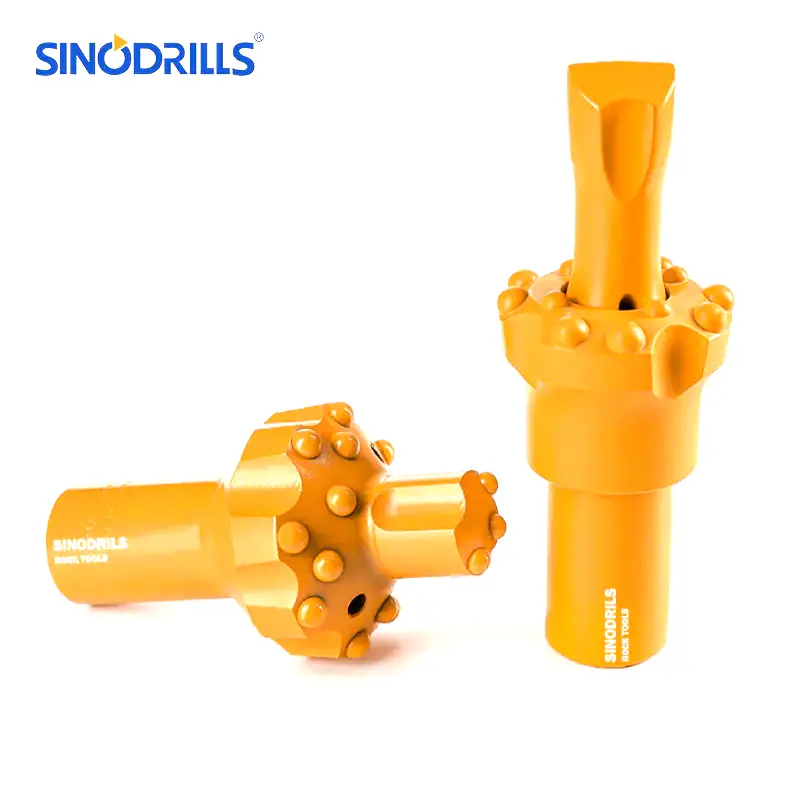Rock reaming is a critical process in hard rock drilling, expanding the pilot hole to the desired diameter for casing or other downhole operations. Selecting the correct rock reamer type is paramount for efficiency, longevity, and overall project success. Choosing the wrong tool can lead to excessive wear, delays, and increased costs.
This blog post will explore the various types of rock reamers, such as roller cone and polycrystalline diamond compact (PDC) reamers, highlighting their specific design advantages. We will guide you through the key considerations and decision-making process for pairing the best reamer with your specific hard rock formation and drilling application requirements.
What are Rock Reamers?
Rock reamers are specialized, heavy-duty drilling tools essential for expanding a pilot hole to a larger, finished diameter, particularly when drilling through hard or abrasive rock formations in applications like oil and gas, mining, or Horizontal Directional Drilling (HDD).
Attached to the drill string and rotated, these tools utilize robust cutting structures—such as roller cones or Polycrystalline Diamond Compact (PDC) cutters—to mechanically grind, crush, or scrape away surrounding rock debris, thereby ensuring a smooth, consistent, and correctly sized borehole to accommodate casing or product pipelines. Their primary function is to increase efficiency, maintain wellbore stability, and prepare the hole for subsequent downhole operations.
Rock Reamer Types
This selection directly impacts the Rate of Penetration (ROP) and overall tool life. Choosing the optimal reamer type—either roller cone or PDC—is the critical decision that ensures a high-quality, in-gauge wellbore and minimizes costly downtime.
To successfully enlarge a borehole in varying hard rock conditions, drilling engineers rely on two primary categories of rock reamers. Each type employs a distinct cutting mechanism tailored to specific rock strengths, hardness levels, and drilling parameters. The choice between them dictates the efficiency and longevity of the reaming phase.
Understanding the operational differences between these primary rock reamer types is crucial for optimizing the Bottom Hole Assembly (BHA) and achieving the fastest and most stable Rate of Penetration (ROP) possible, directly impacting project timelines and costs.
Roller Cone Reamers
Roller cone reamers utilize free-spinning, rotating cutters equipped with tungsten carbide inserts (TCI) or milled steel teeth, similar to tri-cone drill bits. The cutting action primarily involves crushing and grinding the rock formation under heavy weight-on-reamer (WOB). This crushing mechanism makes them exceptionally robust and highly effective in hard, highly abrasive, or fractured rock where impact resistance is critical.
These reamers are designed to withstand high operational stresses and deliver reliable performance in the toughest geological environments. The sealed bearing system within the cones is vital for durability, ensuring the cutting elements continue to rotate efficiently, even in highly abrasive fluid conditions. Roller cone reamers are often the default choice when maximum tool robustness and longevity are paramount in severe drilling environments.
PDC Reamers
PDC (Polycrystalline Diamond Compact) reamers, in contrast, feature fixed cutters integrated directly into the tool body, where the cutting element is a diamond-synthetic composite. These cutters engage the rock by shearing and scraping, offering a much smoother and continuous cutting action compared to the crushing motion of roller cones. This mechanism is ideal for medium-hard, consolidated rock and formations that respond well to shear failure.
The key advantage of PDC reamers is their high rate of penetration (ROP) and exceptional durability in the right applications, as they have no moving parts like bearings or seals to fail. They typically run at higher rotary speeds and lower weight-on-reamer, resulting in a cleaner cut and reduced vibration. While they may be vulnerable to chipping in highly fractured or extremely hard, abrasive quartz formations, their superior ROP in suitable consolidated rock makes them highly valued.
Here are some different types of rock reamers in the following:
| Feature | Roller Cone Reamers | PDC Reamers |
| Primary Cutting Action | Crushing and grinding | Shearing and scraping |
| Ideal Rock Type | Hard, abrasive, fractured, cherty rock | Medium-hard, consolidated, non-abrasive rock |
| Weight on Reamer (WOB) | High | Low to moderate |
| Rotary Speed (RPM) | Low to moderate | Moderate to high |
| Key Advantage | Robustness, tolerance for severe conditions | Higher ROP, no moving parts (bearings/seals) |
| Durability Factor | Depends on bearing/seal life | Depends on cutter wear/chipping resistance |
How to Choose Suitable Rock Reamers?
Choosing the correct rock reamer for a Horizontal Directional Drilling (HDD) project is crucial for efficiency, safety, and project success. The selection process primarily involves matching the reamer’s design and cutting mechanism to the specific geological conditions and the required bore specifications. Failing to select the right tool can lead to excessive wear, slow drilling, or even tool failure.
Key Selection Factors for Rock Reamers
- Geological Formation Hardness and Abrasiveness: The type of rock dictates the cutter technology. Tungsten Carbide Insert (TCI) roller cones are generally best for hard, solid rock like granite, as they crush and grind the formation. Softer or more abrasive rock, like shale or cemented soils, may use Polycrystalline Diamond Compact (PDC) cutters or milled steel teeth that shear or fracture the material more effectively, ensuring optimal penetration rates and tool longevity.
- Required Bore Diameter and Product Pipe Size: The reamer’s size is calculated based on the product pipe’s outside diameter (OD). A common rule suggests the reamer should be 1.25 to 1.5 times the pipe’s OD, creating an annular space for cuttings removal and fluid circulation. For very large-diameter installations in rock, staged reaming (using progressively larger reamers) is often necessary to reduce stress on the drilling rig.
- Drilling Rig Capabilities (Torque and Pullback): The reamer’s aggressiveness and size must align with the drilling rig’s power. An oversized reamer demands high torque to rotate and significant pullback force to pull it through the formation; an insufficient rig may stall or sustain damage. The tool choice must strike an effective balance between rock-cutting performance and the rig’s operational limits.
- Drilling Fluid Volume and Management: Proper mud volume is vital for cooling the rock reamer and effectively transporting cuttings (rock fragments) out of the borehole. Rock reaming generates significant heat and large, abrasive cuttings. The reamer’s design must facilitate adequate fluid flow and cuttings displacement to prevent reamer overheating, binding, or the hole from sloughing or collapsing around the tool.
Conclusion
Successfully navigating hard rock formations demands careful selection of the right reaming tool. We’ve detailed the strengths of common rock reamer types—from robust roller cone reamers designed for crushing tough, abrasive rock to high-speed PDC reamers offering exceptional performance in stable, medium-hard formations. Understanding the geology and your project’s specific demands is the foundation of making an informed, cost-effective decision.
The right rock reamer minimizes vibrations, optimizes rate of penetration (ROP), and ensures the borehole integrity you need for subsequent operations. Investing in a high-quality, appropriately selected reamer drastically reduces downtime caused by tool failure or premature wear, contributing significantly to a project’s profitability and timely completion. Choose wisely to protect your investment.
For reliable, high-performance reaming solutions that meet the toughest industry standards, look no further. We are proud to offer a complete range of rock reamers and reamer hole openers designed for superior durability and efficiency in hard rock. Contact Sinodrills today to get wholesale rock reamers and reamer hole openers and equip your drilling fleet with tools you can trust on any demanding job site worldwide.



